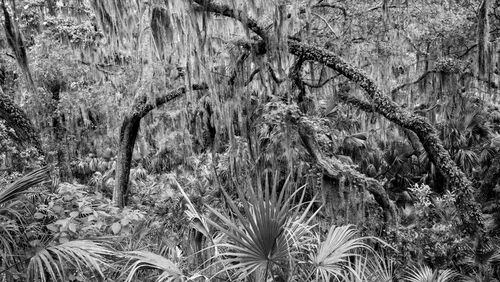The idea for “With Rapture and Astonishment” began with a question.
“What would emerge if people actually use [photography] as a way to deeply listen to the land?” said Susan Patrice, co-founder of Kinship Photography Collective, a photography group that began during the pandemic and evolved into a community of hundreds of photographers connecting with each other from around the world.
The answer is now on display in the University of Georgia Circle Gallery. The exhibit features work from 12 photographers around the Southeast as they explore what it means to listen to the land.
The collective is free and open to anyone to join. It meets weekly online and introduces “calls for engagement,” Patrice said, where someone introduces a topic or question the photographers can explore together.
They wanted to consider the transformative capacity of photography in the world, especially as it relates to the climate movement.
The Kinship Photography Collective partnered with the Blue Ridge Bartram Trail Conservancy, and the 12 photographers spent a few months exploring and creating images on sections of the William Bartram trail. William Bartram was an American botanist, artist and ethnographer, and the trail follows the approximate route he took through eight states, including Georgia.
The exhibition at UGA features a collection of images taken from coastal Georgia to the Blue Ridge mountains.
Credit: Courtesy of Eric William Carroll
Credit: Courtesy of Eric William Carroll
Beate Sass is a Decatur-based photographer originally from New Mexico. She ventured to Cumberland Island and Little St. Simons Island for some of her photos.
She said the work she made at Little St. Simons Island was the most meaningful to her, which included an untouched “maritime forest with these amazing live oaks,” she said.
For Sass, photographing landscapes in the Southeast is challenging because of how cluttered and monochromatic the landscape is here compared to in New Mexico. It was nerve-wracking to take photos on the trail, she said, especially because she only had two days. Usually, it takes time to get to know a place and create meaningful images.
“I just tried to focus on what appeared beautiful to me and what appeared compelling without really thinking whether anybody else was going to appreciate it or not,” Sass said.
Everything about the Collective has informed the way she photographs, she said. This time was no different; it taught her to slow down, look deeply and “learn about the landscape that you’re photographing.”
“I wanted to step into [Bartram’s] shoes and be awed and astonished by what I saw,” Sass said. “And in order to do that, you need to look at things with fresh eyes and not come in with any conceptions of what you’re gonna photograph.”
Although all 12 photographers took pictures of the same section of the trail, the photos turned out quite different from each other.
One artist that came to Patrice’s mind was Raymond Thompson Jr.
Thompson is an assistant professor of photojournalism at the University of Texas in Austin. He said he’s always been interested in looking at landscapes, “specifically from my own experiences as an African American.”
“I’m trying to teach myself to connect with the American landscape,” he said.
Thompson was born in Baltimore and grew up outside Washington, D.C., and didn’t spend much time in outdoor spaces. He makes an effort to try and go to these natural places now, even if it feels weird for him, he said. This was a chance to push his boundaries.
Thompson wanted to depict the insecurity and hyperawareness he feels while walking through the woods. He said there’s an unspoken belief in his family just under the surface that this is not a space for them to venture, and that if he goes there, he should keep his “head on a pivot.”
“You should understand what spaces you’re moving through because you are African American, this is America,” Thompson said. “You have to navigate these spaces with your head on a pivot. You have to know where you are, where you’re stepping, what lane you’re stepping into.”
His work reinterprets fear into hyperawareness of a space. His photos spotlight pieces of fauna; the edges are dark and faded, almost black, while the center spotlights a circular focal point on the ground.
Credit: Courtesy of Raymond Thompson Jr.
Credit: Courtesy of Raymond Thompson Jr.
Thompson said he didn’t consider Bartram’s influence much while working on this body of work. He said walking in Bartram’s footsteps was enough for him, he didn’t feel the need to “internalize his philosophy or approach to the world.”
Thompson isn’t the only photographer who chose not to consider Bartram’s writings.
Mike Belleme, a documentary photographer in Asheville, North Carolina, pushed back against centering Bartram in the exhibit. While he isn’t anti-Bartram, he didn’t see a reason to “center him in a conversation about the natural world in this region.”
“If we’re gonna be talking about people at all, it should be the indigenous folks that we know that have been interacting with these plants for a lot longer and have much deeper relationships to them,” he said.
Belleme photographed a mixture of native and invasive plants for this exhibit, and he used Cherokee names for the native plants. At a future exhibition, he plans to include audio recordings of his Cherokee friend talking about the plants in Cherokee.
Credit: Courtesy of Mike Belleme
Credit: Courtesy of Mike Belleme
Belleme said he let the sun decide what he photographed. While walking through the woods, he looked for a piece of light breaking through the canopy, which he took as a sign to pay attention to that particular plant.
“I wasn’t deciding what I was gonna look at, the sun was, and then it became about the relationship between the sun and the plant,” he said.
Using this light method was a way for Belleme to listen to the woods.
”What we’re doing, technically, is seeing the land, not listening to land, but I think that title prompts you to do that differently,” Belleme said. “It’s get past just the visual and actually try to interact in a more cross-sensory and deeper way with the landscape.
IF YOU GO
“With Rapture and Astonishment”
Through Sept. 12. 9 a.m.- 5 p.m. weekdays with a public reception 3-6 p.m. Aug. 5. University of Georgia Circle Gallery, College of Environment & Design, 285 S. Jackson St., Athens. 706-542-8292, blueridgebartram.org.
About the Author











